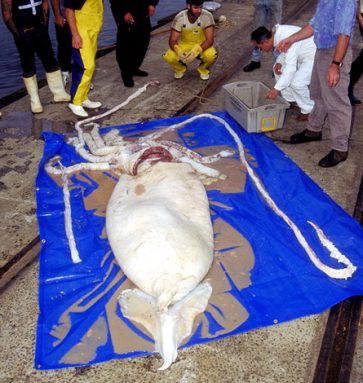Big squid: All one family
Genes show all giant squid belong to one, worldwide species

Resembling huge, squishy darts with tentacles, giant squid live in the darkest depths of the ocean. People seldom see these mysterious creatures. But scientists just got to know the animals much better. In a study published in March, researchers clear up a long-standing mystery about how closely these animals are related. They find the colossal creatures belong to a single global species.
A species is a group of organisms that are similar enough to breed with each other. Until now, scientists had thought that giant squid belonged to three different species. One species lived in the North Atlantic Ocean, another in southern oceans and a third in waters near Japan. But the new analysis shows that the giant squid from all of these regions are the same species, says Clyde Roper. He’s a marine biologist and squid expert who used to work at the Smithsonian National Museum of Natural History. He did not take part in the new study.
M. Thomas Gilbert, who did participate in the new study, says he and other squid scientists “were very surprised by the results.” Gilbert is a geneticist, a scientist who studies genes, at the Natural History Museum of Denmark in Copenhagen.
Genes pass traits from parents to offspring. They’re contained in DNA, a molecule found inside almost every cell of every living thing. Genes provide instructions that tell each cell how to make molecules called proteins. Proteins make up many things, including skin, hair, muscle and bone; they also control the operations inside cells.
Individuals of the same species have very similar genes. That likeness is what Gilbert’s group found among squid from oceans the world over. The team looked at genes from 43 different giant squid. Taking such a close look at so many squid was no small feat: Most of what we know about these creatures comes from their carcasses that have washed ashore or have been found in the bellies of dead whales.
The genetic study solved one mystery — the number of giant squid species — but turned up another. In general, only species with small populations are as genetically similar as giant squid are. But giant squid aren’t scarce. In fact, some researchers estimate there may be hundreds of millions. So scientists are searching for a clear explanation for why the squid are so similar but numerous.
The public perception of giant squid is that they are rare. But the creatures seem rare only because they inhabit a different part of the planet than we do, Roper told Science News. “We don’t go where they go very often, and they don’t go where we go.”
Books like Moby Dick and 20,000 Leagues Under the Sea have depicted these animals as sea monsters. And no wonder. Their eyes are larger than a human head. They use a parrotlike beak to dismember their prey. And their tentacles seem to go on forever. Stretched out, a giant squid reaches from the pitcher’s mound almost to home plate in a major league baseball park.
Power Words
giant squid A deep-sea squid that is the largest known invertebrate, reaching a length of 59 feet (18 m) or more.
gene A sequence of DNA. Such sequences determine a particular feature in an organism (such as eye color or risk of disease). Genes contain the instructions for building proteins and are passed from parents to offspring.
DNA, or deoxyribonucleic acid A long, spiral-shaped molecule inside nearly every cell of an organism. It carries genetic information. DNA may be found in the nucleus of the cell or in the mitochondria, which is the cell’s power plant.
protein Compounds that are an essential part of all living organisms. Proteins do the work inside a cell. They may also be parts of body tissues such as muscle, hair and collagen. Proteins may also be enzymes and antibodies.
species A group of organisms consisting of similar individuals capable of exchanging genes, or interbreeding.







